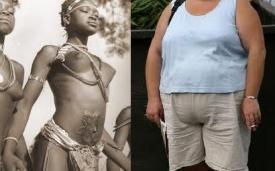|
Food Nutrition Facts for lifetime fitness
Food Nutrition facts: one Diet is the key component of health. We humans have had a long history of dietary development to get to where we are today but the nutrition in the modern world is very different from the diet available in the ancestral environment in which our bodies developed Today we live long lives but they are often marred by degeneration of the body, terminal illnesses, obesity, stiffness, arthritis, alzheimers, high blood pressure, osteoporosis, diabetes and a host of other complaints.
But you know, it wasn’t always this way. At one point in our history there was a time when humans were tall and strong-boned with no tooth decay, high levels of iron in their blood and very little disease. This was the time of the Paleolithic period (the stone-age) when every human was a hunter-gatherer. And then, according to anthropologist Jared Diamond, about ten thousand years or so ago, agriculture arose and as he puts it, we made the ‘worst mistake in the history of the human race’. After the advent of agriculture and the abandonment of the hunter gatherer lifestyle forensic studies have shown that the people became smaller and weaker-boned, caries (tooth decay) became prevalent and anemia became common. Infectious diseases also increased dramatically due to the sedentary crowded habitat of villages and then cities.
Food Nutrition facts: two Our health was better before the advent of agriculture Agriculture allowed us to develop modern civilization, with all the positives and negatives that encompasses, but it may not have been good news for our health. Our modern diet varies dramatically from that of the Paleolithic period especially in relation to the use of grains, dairy products and fat and many suggest that their diet kept stone-age people free of the diseases of civilization - hypertension, heart disease, obesity, cancer and diabetes.
Food Nutrition facts: three Hunter-gatherer groups were virtually free of the diseases of modern civilization In Australian Aboriginal groups for instance, there are very high incidences of obesity, diabetes and renal disease that were not present when they lived a traditional lifestyle. In 1982 Dr. Kerin O’Dea took a group of middle-aged Aboriginal people with diabetes back to the bush to revert to their traditional hunter-gatherer lifestyle. After seven weeks there was a major improvement in their weight, diabetes and other health risk factors. Other examples abound, including the Eskimo people whom the arctic explorer and anthropologist Vilhjalmur Stefansson found lacked a single case of cancer until they adopted a western diet, and the Kitavan people of the Trobriand islands, Papua New Guinea, whose traditional diet is high in coconut fat but appears to give them good health into old age without the onset of ‘civilised’ diseases.
Food Nutrition facts: four Contrary to popular opinion hunter-gatherers did not live short lives If you have a population of 100 people with 50 dying at birth and the other fifty living to 100 years old you will get an average lifespan of 50 years but it doesn't reflect reality. High birth mortality sways the data towards a lower lifespan. There is plenty of evidence of hunter-gatherers living to great age and there is evidence throughout recorded history of ancient humans living to ages comparable with the modern era and living in better health. TIP: A key component of health and an immediate way of increasing your lifespan now is to eat more fruit and vegetables.
Food Nutrition facts: five The greatest difference between ourselves and our ancestors is in our diet and exercise patterns The modern diet is awash in a sea of abundant carbohydrates. Something that our ancestors had limited access to but now appear on most shelves in our supermarkets. Our bodies were designed to use carbohydrates but not in immense quantities. Also, the typical hunter-gatherer walked about 14 kilometres every day, a distance many of us would be lucky to cover in a fortnight.
Food Nutrition facts: six Our bodies are designed to eat an optimum diet for our species. If we consume an optimum diet and move our bodies in accordance with ancestral activity patterns then we will remain healthy for a lifetime The problem is that we were not given a body maintenance manual at birth so we have to research and experiment to find the best diet for us. In the following pages I will cover a range of diets and aspects of health drawing on the lifestyles of hunter-gatherers around the world. It is up to you to find those nutrition facts that will enhance your life, not destroy it prematurely. Healthy eating and exercise patterns are easy to acquire. You just do them until they become habit. Eating healthy simply means making a choice for your health every time you eat but first you have to know what type of diet is really healthy There are a variety of diets that will keep you in good health and some that won't. You can learn about them through the following links: Paleolithic diet, My recommendation is the Paleolithic diet as the best diet followed by the Zone diet though the Zone is probably the easier of the two to follow. Good luck
Leave Food Nutrition Facts page and return to Home page
|





